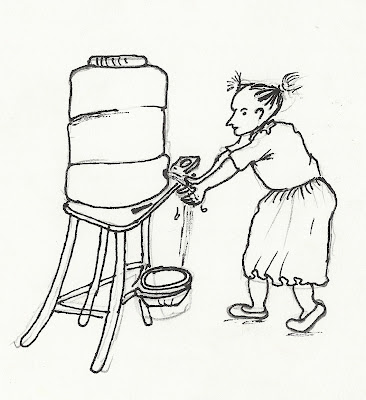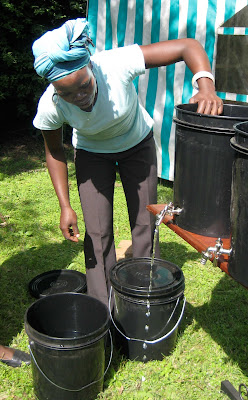I’m sitting in a ramshackle compound in Silanga village, one of the deepest and most neglected areas of Kibera slum, with an impossible task. As one of the Water and Sanitation health workers on this project I’m supposed to be training the locals on how to make safe storage containers for drinking water. Back in the United States our WATSAN team often spoke of employing this simple technology. In the field it would be a core strategy in getting our target population to drink clean water. I’ve got a bucket and a little metal valve, but no way to attach the two. In a place like Kibera resources are hard to come by and tools are no exception.
After asking around for a while, Hellen, one of the residents that we’re working with, disappears and comes back with a hammer and one nail. It’s not the ideal situation, but I decide to make do with what we’ve got. At least I can make a hole in the bucket. I start hammering, but am unable to drive the nail through the plastic. I’m about to give up when one of our partners from a local NGO bursts through the door, fresh from his office in town.
“What are you doing?” He exclaims. “You’re not going to get the nail into that thing without stabilizing it first.”
My partner grabs a large rock from the ground and puts it into the bottom of the bucket. He gives the nail a whack and down it goes. His satisfied grin immediately fades when I show him the valve that needs to fit in the pin-sized hole.
“So what you do now, eh, is make that nail hot, hot,” he explains. “Then you move it around in the hole to melt the plastic.”
I ask Hellen for a candle and this makes my partner scowl.
“No! You need to heat it up on a stove. The nail is going to be really hot so you better get some pliers to hold it.”
Hellen doesn’t have a stove, nor does she have a pair of pliers. I ask my partner what to do and he gestures with his hand to call around. Then he disappears out the door to meet with some community elders and presumably work his way back to the office.
I call the only person I know in Silanga, my security guide who accompanies me into the slum. As usual he doesn’t pick up his phone. I sit on the bucket defeated.
Hellen comes around and asks me why I’m not working on the water container. I tell her that I’ll organize better and we’ll do it tomorrow. She shakes her head.
“Give me the bucket,” she says.
I sigh and stand up. She grabs the bucket and punches at it a few times with a big dull knife that has been laying around the compound. As a crude hole takes shape she takes the metal valve and forces it into place. Then, with a flip of the wrist she splashes the contents of a basin into her new safe water container.
Herein lies a parable.


